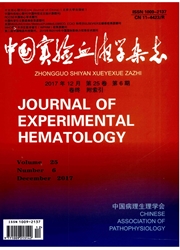

 中文摘要:
中文摘要:
目的:通过回顾性分析中国北方15个血液病研究中心的586例伴有t(8;21)的急性髓系白血病(AML)患者临床资料,总结其在外周血、免疫分型、融合基因、细胞遗传学改变等的临床特点。方法:用COX回归进行预后因素的单因素和多因素分析,探究能够影响t(8;21)AML患者预后生存的因素。结果:t(8;21)AML患者的免疫分型中以HLA-DR+、CD117+、CD34+、MPO+、CD38+、CDl3+、CD33+多见(〉95%),部分患者伴有CD19+和CD56+;最常见的伴随基因突变为C-KIT突变(37.8%);除t(8;21)异位外,最常见的伴随染色体异常为性染色体缺失(38.9%);单因素分析显示,初诊时WBC≤3.5×10^9/L、不伴随C-KIT突变、做过HSCT的成人t(8;21)AML患者在OS、PFS上均有明显优势(P〈0.05),不伴有髓外浸润、CD19+患者仅在OS上具有优势;多因素分析显示,WBC≤3.5×10^9/L的患者在OS、PFS上均优于WBC〉3.5×10^9/L的患者(P〈0.05)。结论:中国的t(8;21)AML患者临床特征与报道的国外人群基本相似,WBC≤3.5×10^9/L是t(8;21)AML的预后良好因素,C-KIT突变是t(8;21)AML的预后不良因素。
 英文摘要:
英文摘要:
Objective: To summarize the clinical characteristics of peripheral blood,immune phenotypes,fusion genes and cytogenetics of patients with t( 8; 21) acute myeloid leukemia( AML) through the retrospective analysis of 586 patients with t( 8; 21) AML from 15 blood disease research centers in Northern area of China. Methods: The factors affecting prognosis of patients with t( 8; 21) AML were investigated by using univariate and multivariate COX regression. Results: The immune type of t( 8; 21) AML patients was mainly with HLA-DR+,CD117+,CD34 +,MPO+,CD38+,CD13+ and CD33+( 95%),part of them with CD19 + and CD56 +; the most common accompanied mutation of t( 8; 21) AML patients was C-KIT mutation( 37. 8%); in addition to t( 8; 21) ectopic,the most common chromosomal abnormality was sex chromosome deletions( 38. 9%). The univariate analysis revealed a significant survival superiority of OS and PFS in t( 8; 21) AML patients of WBC≤3. 5 × 109/L without C-KIT mutation,the newly diagnosed ones achieved HSCT( P〈0. 05),only survival superiority on OS in t( 8; 21) AML patients with extramedullary infiltration and CD19 positive; the results of multivariate analysis showed a significant survival superiority on OS and PFS in t( 8; 21) AML patients with WBC≤3. 5 × 10^9/L( P〈0. 05). Conclusion: The clinical features of t( 8; 21) AML patients in China are similar to those in other countries,WBC≤3. 5 × 109/L is a good prognostic factor while the C-KIT mutation is a poor one in t( 8; 21) AML patients.
 同期刊论文项目
同期刊论文项目
 同项目期刊论文
同项目期刊论文
 期刊信息
期刊信息
